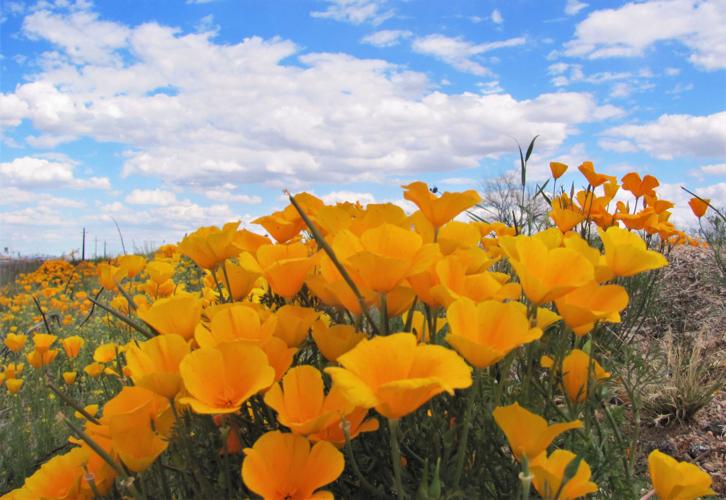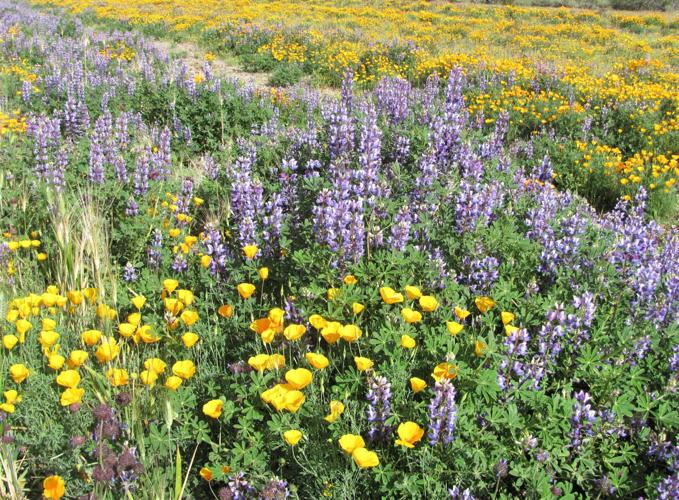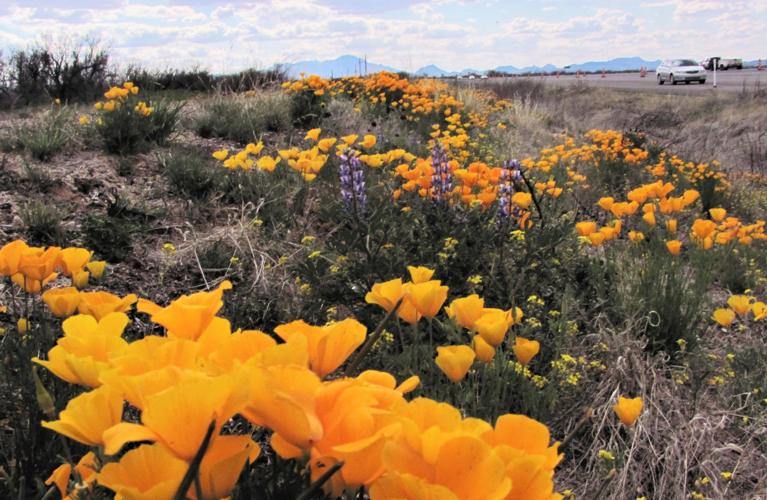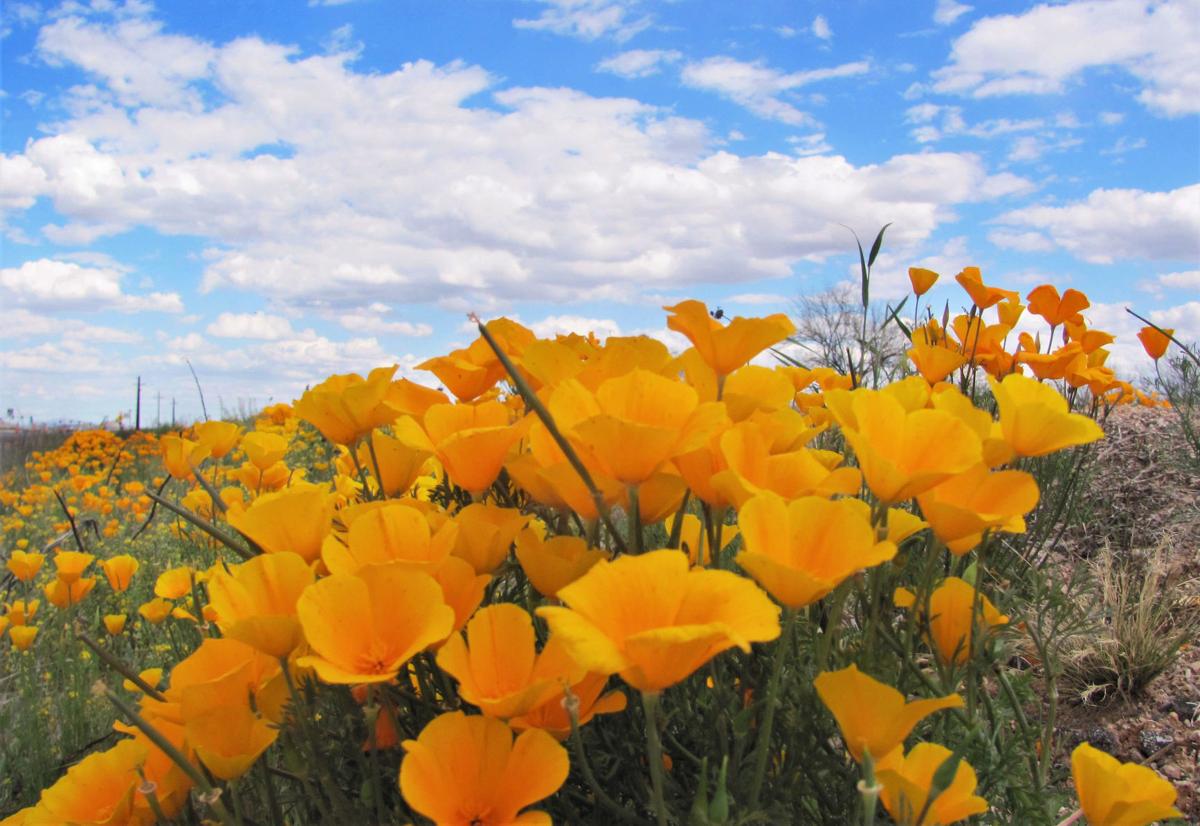Carpets of gold poppies and blue lupines — the grandest displays in recent years — are lining the sides of Arizona 86 southwest of Tucson this week.
It’s drive-by desert scenery at its colorful best and just a short journey from the city.
Poppies are the standouts, with countless thousands of blooms covering the desert in some places.
You’ll get pretty good views from the car. But if you have time to find a safe place to pull off the road and park, the wildflowers are even more impressive with a close-up view.
To get to the area, follow Ajo Way west out of Tucson and it becomes Arizona 86.
A fortunate combination of well-timed winter rains followed by moderate weather helped produce brilliant blooms just as spring was officially beginning.
John Wiens, of the Botany Department at the Arizona-Sonora Desert Museum, described factors leading to a good spring bloom.
“What we’ve always said is that the seeds for the spring annuals have to germinate in the fall, between the end of September and mid-December,” Wiens said.
“What needs to go right,” he said, “is a large rain event — around 1 inch or more. And temperatures must be on the cool side — daytimes in the low 80s or lower.”
If those conditions exist, seeds are germinated.
“But to sustain life, they need subsequent rains of around 1 inch per month,” Wiens said. “They grow until temperatures trigger blooms — anytime from mid-December to March. Deep freezes will not bother these annuals, unless flowering has begun.”
Things that can disrupt the process, he said, include a prolonged dry spell after germination and high temperatures — mid-80s or higher for a week or so.
“And, even if the right things happen, we can get mixed results,” Wiens noted. “In short, there is still much to be learned to be able to predict blooms. I’m just pleased to be surprised, like I am this year.”

This explosion of gold poppies and blue lupines makes you wonder where the desert went.

Drivers on Arizona 86 southwest of Tucson see grand displays of wildflowers on both sides of the road.
27 spectacular photos of spring wildflowers around Tucson
Spring Wildflowers
Updated
Spring poppies and other wildflowers are in bloom and all over at Picacho Peak State Park on March 5.
Spring Wildflowers
Updated
Spring poppies and other wildflowers are in bloom and all over at Picacho Peak State Park on March 05, 2019.
Spring Wildflowers
Updated
Spring poppies and other wildflowers are in bloom and all over at Picacho Peak State Park on March 05, 2019.
Spring Wildflowers
Updated
Paul and Karen Reese stand on a picnic table to get a better view of blooming wildflowers at Picacho Peak State Park on March 05, 2019.
Spring Wildflowers
Updated
Spring poppies and other wildflowers are in bloom and all over at Picacho Peak State Park on March 05, 2019.
Spring Wildflowers
Updated
Spring poppies and other wildflowers are in bloom and all over at Picacho Peak State Park on March 05, 2019.
Spring Wildflowers
Updated
Spring poppies and other wildflowers are in bloom and all over at Picacho Peak State Park on March 05, 2019.
Spring Wildflowers
Updated
Paul Reese uses an iPad to take photos of the spring wildflowers in bloom at Picacho Peak State Park on March 05, 2019.
Spring Wildflowers
Updated
Merlin Jewell uses his iPhone to take photos of the spring wildflowers in bloom at Picacho Peak State Park on March 05, 2019.
Spring Wildflowers
Updated
Pat and Eileen Mason, sisters, walk along the Children's Cave loop to take in the spring wildflowers at Picacho Peak State Park on March 05, 2019.
Picacho Peak blooms
Updated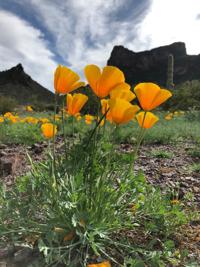
Standout early blooms at Picacho Peak State Park include brilliant gold poppies.
Poppies on SR 86
Updated
Drivers on Arizona 86 southwest of Tucson see grand displays of wildflowers on both sides of the road.
Vast carpets of wildflowers
Updated
Vast carpets of gold poppies and blue lupines line the sides of Arizona 86 southwest of Tucson. -- Credit: Doug Kreutz/Arizona Daily Star
Carpets of wildflowers
Updated
Carpets of gold poppies and blue lupines line the sides of Arizona 86 southwest of Tucson. -- Credit: Doug Kreutz/Arizona Daily Star
Wildflowers trail side
Updated
Lovely patches of bright yellow and purple wildflowers can be seen along the Canyon Loop Trail at Catalina State Park.
Wildflowers
Updated
This grassy field in Catalina State Park was peppered with orange and purple wildflowers.
Saguaro National Park
Updated
Saguaro National Park west of Tucson is alive with wildflower color, and its parking lots are crowded. In the park’s eastern unit, pullouts along the Cactus Forest Loop Drive are filling up daily.
Wildflowers and saguaro
Updated
Wildflowers and a small saguaro at Saguaro National Park west of Tucson. -- Credit: Doug Kreutz/Arizona Daily Star
Blue lupine
Updated
Blue lupine wildflowers are in brilliant bloom at Saguaro National Park west of Tucson. -- Credit: Doug Kreutz/Arizona Daily Star
Hikers and wildflowers
Updated
Hikers on the Linda Vista Trail northwest of Tucson pass lots of brittlebush wildflowers along the way.
Poppies in bloom
Updated
Poppies in bloom at Saguaro National Park west of Tucson. — Credit: Doug Kreutz/Arizona Daily Star
Gold poppies
Updated
Gold poppies stand out against a backdrop of cacti and blue desert sky at Saguaro National Park west of Tucson on March 11, 2019. — Credit: Doug Kreutz/Arizona Daily Star
Carpet of poppies
Updated
Gold poppies carpet the landscape at some sites in Saguaro National Park west of Tucson. Blue lupine and orange globemallow can also be seen in the area.


